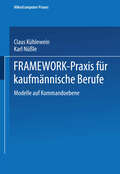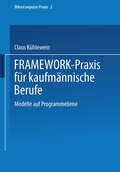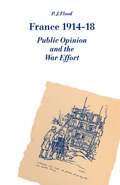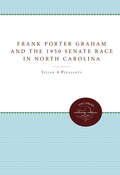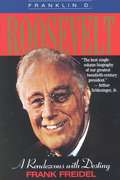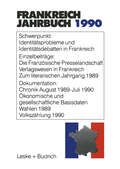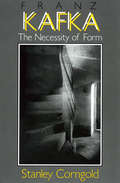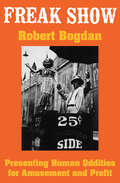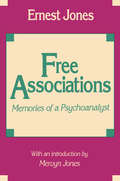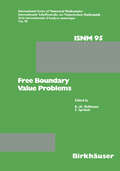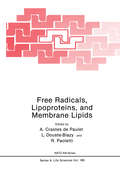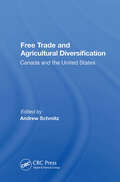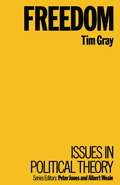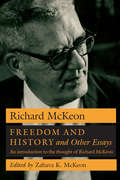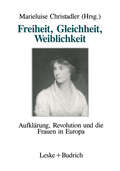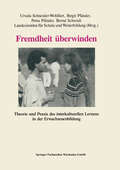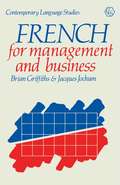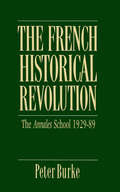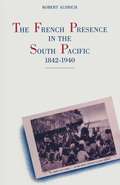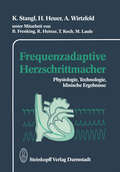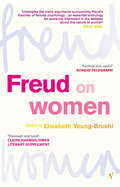- Table View
- List View
FRAMEWORK-Praxis für kaufmännische Berufe: Band 1: Modelle auf Kommandoebene (MikroComputer-Praxis)
by Claus Kühlewein Karl NüßleWie sieht es mit der Datenverarbeitung in den kaufmännischen Berufen aus? Seit jeher sind diese Berufe durch vielfältiges Zahlenmaterial und umfangreiche Be rechnungen geprägt. Was mit Bleistift, Tischrechenmaschine, Buchungs- und Fakturierautomaten erledigt wurde, konnte nach 1960 in großem Umfange von zentralen elektronischen Großrechnern übernommen werden. Mit der Entwicklung der Personalcomputer seit 1977 ist eine neue Epoche für die kaufmännischen Be rufe angebrochen, deren Wirkung noch gar nicht absehbar ist. Die zentrale Groß-EDV ist tot! Es lebe die dezentrale Pe-Anwendung! So könnte das Motto der neunzi ger Jahre lauten. Mit dem Werkzeug Personalcomputer ist insbesondere für die kaufmännischen Berufe eine neue Qualität entstanden. Auf jedem Schreibtisch kann heute eine EDV-Lelstung angeboten werden, die 1970 noch mit einem Millionenaufwand verbunden war. Hinzu kommt, daß der Vorteil der zentralen Datenhaltung in der Groß-EDV durch leistungsfähige Vernetzungen der Personalcomputer und öffentliche Datennetze erhalten bleiben kann. Aber auch bei den Personalcomputern hat sich in den letzten zehn Jahren schon eine kleine Revolution vollzogen. Mußten zunächst die notwendigen Programme noch aufwendig selbst programmiert werden, so gibt es heute für jeden Bedarf leistungsfähige und zugleich preiswerte Standardprogramme. Niemand muß heute in einem kaufmännischen Beruf seine Standardanwendungen mit großem Zeitauf wand und hoher Fehleranfälligkelt mehr selbst programmieren.
FRAMEWORK-Praxis für kaufmännische Berufe: Modelle auf Programmebene (MikroComputer-Praxis)
by Dipl.-Wirtsch.-Ing. Claus Kühlewein Dipl.-Handelslehrer Karl NüßleKaufmännische Anwendungen auf einem Personalcomputer mit Hilfe von Stan dardsoftware? Ist dieser Ansatz für die heutigen Anforderungen akzeptabel? Die beiden Autoren haben bereits im ersten Band den Nachweis geliefert, daß viele der routinemäßigen Berechnungen, die in kaufmännischen Berufen notwendig sind, mit relativ geringem Aufwand auf der Ebene eines Personalcomputers und einer integrierten Standardsoftware wie Framewerk erledigt werden können. Der Personalcomputer ist aus den kaufmännischen Anwendungen heute nicht mehr wegzudenken. Er stellt immer meh"r die kostengünstige Basis jeder elektro nischen Datenverarbeitung dar. Insbesondere macht er den ausgebildeten EDV Programmierer entbehrlich und liefert den Zugang zur schnellen und effektiven Informationsverarbeitung für jedermann/frau. Nur so ist es überhaupt möglich, die notwendige Breite der Anwendungen bei fehlenden EDV-Spezialisten zu ge winnen. Während der erste Band bis auf einfache Makrostrukturen ganz ohne einen eige nen Programmieraufwand auskommen konnte, erweitert der hier vorgelegte Band nun den Horizont in den Bereich der direkten Anwendung in einer integrierten Programmierumgebung. Was hat man darunter zu verstehen? Framewerk ist zunächst das Beispiel für die wirkungsvolle Verbindung einer Textverarbeitung, Tabellenkalkulation, Business-Grafik und Dateiverwaltung in einer gemeinsamen Daten- und Konzeptumgebung. Framewerk enthält als integriertes Standardpaket aber zusätzlich noch eine Pro grammiersprache FRED (Framework-Editor), mit dem sich die genannten Stan dardbausteine für sich allein und untereinander äußerst wirkungsvoll ausbauen lassen. Diese Möglichkeit wird nicht generell erforderlich sein. Das bedeutet, daß nicht jeder Anwender von Framewerk individuell durch die Hintertür wieder zum Programmierer werden muß.
France 1914–18: Public Opinion and the War Effort
by Patrick FloodA study conducted locally in south-east France which aims to discover how the civilian population held out against occupying troops during World War I. Incorporating individual case studies, the text details the nature and extent of the hardships and sacrifices made by the local people.
Frank Porter Graham and the 1950 Senate Race in North Carolina
by Julian M. Pleasants Augustus M. BurnsThe tumultuous North Carolina Senate primaries of 1950 are still viewed as the most bitter chapter in the state's modern political history. The central figure in that frenzied race was the appointed incumbent, Frank Porter Graham, former president of the University of North Carolina (1931-49) and liberal activist of national stature.As a Senate candidate, Graham was unrelentingly attacked for both his social activism and his racial views, and the vicious tactics used against him shocked his supporters and alarmed national observers. Peeling away the myths that have accumulated over the years, the authors present the first thoroughly researched account of Graham's eventual defeat by Raleigh attorney Willis Smith. The result, a balanced study of North Carolina politics at mid-century, is a convincing explanation of the 1950 election.Using the campaign as a prism, the authors assess the factional struggles within the state, showing that Graham was defeated by a massive loss of support among white voters in eastern North Carolina. The principal force behind this switch was the fear promulgated by the Smith campaign that a vote for Graham was a vote to end statutory segregation in North Carolina. The authors also offer the fullest portrait to date of Frank Porter Graham as political candidate and social reformer. They examine his career as an educator and public activist, the steps that led to his unorthodox appointment, and his strengths and weaknesses as a political candidate.Frank Porter Graham and the 1950 Senate Race in North Carolina is based on manuscript materials never before examined, on interviews with more than 50 campaign participants and associates of both Graham and Smith, and on a thorough analysis of newspaper coverage and campaign literature.Originally published in 1990.A UNC Press Enduring Edition -- UNC Press Enduring Editions use the latest in digital technology to make available again books from our distinguished backlist that were previously out of print. These editions are published unaltered from the original, and are presented in affordable paperback formats, bringing readers both historical and cultural value.
Franklin D. Roosevelt: A Rendezvous With Destiny
by Frank FreidelThis is a one-volume biography of one of the greatest presidents and world leaders of the 20th century. Drawing upon extensive sources and recent scholarship, it examines the moulding and maturing of the complex inner man and the dynamic, charming public figure. The focus is upon Roosevelt's often controversial ideas and actions as he undertook through the New Deal to modernize the nation, and during World War II to take the lead in establishing a secure world order. The portrait that emerges is of a president possessed of superb political instincts surprisingly mainstream in his political beliefs.
Frankreich-Jahrbuch 1990: Politik, Wirtschaft, Gesellschaft, Geschichte, Kultur
by Deutsch-Französiches Institut Lothar Albertin Marieluise Christadler Gerhard Kiersch Ingo Kolboom Adolf Kimmel Robert PichtFranz Kafka: The Necessity of Form
by Stanley CorngoldIn Stanley Corngold’s view, the themes and strategies of Kafka’s fiction are generated by a tension between his concern for writing and his growing sense of its arbitrary character. Analyzing Kafka’s work in light of "the necessity of form," which is also a merely formal necessity, Corngold uncovers the fundamental paradox of Kafka’s art and life. The first section of the book shows how Kafka’s rhetoric may be understood as the daring project of a man compelled to live his life as literature. In the central part of the book, Corngold reflects on the place of Kafka within the modern tradition, discussing such influential precursors of Cervantes, Flaubert, and Nietzsche, whose works display a comparable narrative disruption. Kafka’s distinctive narrative strategies, Corngold points out, demand interpretation at the same time they resist it. Critics of Kafka, he says, must be aware that their approaches are guided by the principles that Kafka’s fiction identifies, dramatizes, and rejects.
Freak Show: Presenting Human Oddities for Amusement and Profit
by Robert BogdanFrom 1840 until 1940, freak shows by the hundreds crisscrossed the United States, from the smallest towns to the largest cities, exhibiting their casts of dwarfs, giants, Siamese twins, bearded ladies, savages, snake charmers, fire eaters, and other oddities. By today's standards such displays would be considered cruel and exploitative—the pornography of disability. Yet for one hundred years the freak show was widely accepted as one of America's most popular forms of entertainment. Robert Bogdan's fascinating social history brings to life the world of the freak show and explores the culture that nurtured and, later, abandoned it. In uncovering this neglected chapter of show business, he describes in detail the flimflam artistry behind the shows, the promoters and the audiences, and the gradual evolution of public opinion from awe to embarrassment. Freaks were not born, Bogdan reveals; they were manufactured by the amusement world, usually with the active participation of the freaks themselves. Many of the "human curiosities" found fame and fortune, becoming the celebrities of their time, until the ascent of professional medicine transformed them from marvels into pathological specimans.
Freak Show: Presenting Human Oddities for Amusement and Profit
by Robert BogdanFrom 1840 until 1940, freak shows by the hundreds crisscrossed the United States, from the smallest towns to the largest cities, exhibiting their casts of dwarfs, giants, Siamese twins, bearded ladies, savages, snake charmers, fire eaters, and other oddities. By today's standards such displays would be considered cruel and exploitative—the pornography of disability. Yet for one hundred years the freak show was widely accepted as one of America's most popular forms of entertainment. Robert Bogdan's fascinating social history brings to life the world of the freak show and explores the culture that nurtured and, later, abandoned it. In uncovering this neglected chapter of show business, he describes in detail the flimflam artistry behind the shows, the promoters and the audiences, and the gradual evolution of public opinion from awe to embarrassment. Freaks were not born, Bogdan reveals; they were manufactured by the amusement world, usually with the active participation of the freaks themselves. Many of the "human curiosities" found fame and fortune, becoming the celebrities of their time, until the ascent of professional medicine transformed them from marvels into pathological specimans.
Freak Show: Presenting Human Oddities for Amusement and Profit
by Robert BogdanFrom 1840 until 1940, freak shows by the hundreds crisscrossed the United States, from the smallest towns to the largest cities, exhibiting their casts of dwarfs, giants, Siamese twins, bearded ladies, savages, snake charmers, fire eaters, and other oddities. By today's standards such displays would be considered cruel and exploitative—the pornography of disability. Yet for one hundred years the freak show was widely accepted as one of America's most popular forms of entertainment. Robert Bogdan's fascinating social history brings to life the world of the freak show and explores the culture that nurtured and, later, abandoned it. In uncovering this neglected chapter of show business, he describes in detail the flimflam artistry behind the shows, the promoters and the audiences, and the gradual evolution of public opinion from awe to embarrassment. Freaks were not born, Bogdan reveals; they were manufactured by the amusement world, usually with the active participation of the freaks themselves. Many of the "human curiosities" found fame and fortune, becoming the celebrities of their time, until the ascent of professional medicine transformed them from marvels into pathological specimans.
Freak Show: Presenting Human Oddities for Amusement and Profit
by Robert BogdanFrom 1840 until 1940, freak shows by the hundreds crisscrossed the United States, from the smallest towns to the largest cities, exhibiting their casts of dwarfs, giants, Siamese twins, bearded ladies, savages, snake charmers, fire eaters, and other oddities. By today's standards such displays would be considered cruel and exploitative—the pornography of disability. Yet for one hundred years the freak show was widely accepted as one of America's most popular forms of entertainment. Robert Bogdan's fascinating social history brings to life the world of the freak show and explores the culture that nurtured and, later, abandoned it. In uncovering this neglected chapter of show business, he describes in detail the flimflam artistry behind the shows, the promoters and the audiences, and the gradual evolution of public opinion from awe to embarrassment. Freaks were not born, Bogdan reveals; they were manufactured by the amusement world, usually with the active participation of the freaks themselves. Many of the "human curiosities" found fame and fortune, becoming the celebrities of their time, until the ascent of professional medicine transformed them from marvels into pathological specimans.
Free Associations: Memories of a Psychoanalyst
by Booker T. WashingtonFirst published in 1958, Free Associations is the story of the early life of Ernest Jones. It was prepared for publication by his son Mervyn, who contributed an epilogue covering the period from 1918 (when this book ends) through Jones's death in 1944. This new edition includes a reflective introduction by Mervyn Jones, in which he writes about Ernest Jones "as I could not write in 1958."One of the pioneers in psychoanalysis, Ernest Jones was active in advancing the status as well as the development of the field. In the wider forum of public opinion, he made himself an advocate of the new science-the Huxley, he liked to say, to Freud's Darwin. Huxley had ranked below Darwin in creative originality, and had filled the role of the faithful and indispensably useful follower; and Mervyn Jones believes both Freud and Jones were pleased by the comparison. In addition to his important public and organizational roles (as president of the British and International Psychoanalytic Associations), Jones made significant contributions to psychoanalytic theory. When the Nazis invaded Vienna, he saved much of the assets and archives of psychoanalysis, at great personal risk, and made the arrangements for Freud to come to London.In his introduction, Mervyn Jones presents a sometimes surprising portrait of a thoroughly conventional man in what was then an unconventional profession. He describes tensions and conflicts among the early Freudians, and situates Freudianism with other theories that laid claim to scientific truth in the late nineteenth century.Free Associations presents an evocative picture of Wales and London at the turn of the century, and describes the developing profession of psychoanalysis. It is a dramatic story of success and failure, and of a young man and how he responded to the new, strange ideas of Freud. This book fills in our understanding of the history of psychoanalysis and its founders.
Free Associations: Memories of a Psychoanalyst
by Booker T. WashingtonFirst published in 1958, Free Associations is the story of the early life of Ernest Jones. It was prepared for publication by his son Mervyn, who contributed an epilogue covering the period from 1918 (when this book ends) through Jones's death in 1944. This new edition includes a reflective introduction by Mervyn Jones, in which he writes about Ernest Jones "as I could not write in 1958."One of the pioneers in psychoanalysis, Ernest Jones was active in advancing the status as well as the development of the field. In the wider forum of public opinion, he made himself an advocate of the new science-the Huxley, he liked to say, to Freud's Darwin. Huxley had ranked below Darwin in creative originality, and had filled the role of the faithful and indispensably useful follower; and Mervyn Jones believes both Freud and Jones were pleased by the comparison. In addition to his important public and organizational roles (as president of the British and International Psychoanalytic Associations), Jones made significant contributions to psychoanalytic theory. When the Nazis invaded Vienna, he saved much of the assets and archives of psychoanalysis, at great personal risk, and made the arrangements for Freud to come to London.In his introduction, Mervyn Jones presents a sometimes surprising portrait of a thoroughly conventional man in what was then an unconventional profession. He describes tensions and conflicts among the early Freudians, and situates Freudianism with other theories that laid claim to scientific truth in the late nineteenth century.Free Associations presents an evocative picture of Wales and London at the turn of the century, and describes the developing profession of psychoanalysis. It is a dramatic story of success and failure, and of a young man and how he responded to the new, strange ideas of Freud. This book fills in our understanding of the history of psychoanalysis and its founders.
Free Boundary Value Problems: Proceedings of a Conference held at the Mathematisches Forschungsinstitut, Oberwolfach, July 9–15, 1989 (International Series of Numerical Mathematics #95)
by HOFFMANN SPREKELSThis monograph contains a collection of 16 papers that were presented at the confer ence "Free Boundary Problems: Numerical 7reatment and Optimal Control", held at the Mathematisches Forschungsinstitut Oberwolfach, West Germany, July 9-15, 1989. It was the aim of the organizers of the meeting to bring together experts from different areas in the broad field of free boundary problems, where a certain emphasis was given to the numerical treatment and optimal control of free boundary problems. However, during the conference also a number papers leading to important new theoretical insights were presented. The strong connection between theory and applications finds its reflection in this monograph which contains papers of high theoretical and numerical interest, as well as applications to important practical problems. Many of the contributions are concerned with phase transition phenomena, a field which was of particular importance during the meeting; topics like spinodal decomposition, shape memory alloys, crystal growth and flow through porous media are addressed. Another field of major interest during the con ference was fluid flow; also this field is addressed in this volume. The volume opens with a contribution by H. W. Alt and I. Pawlow. In their paper the problem of spinodal decomposition is treated in the non-isothermal situation. For the first time the existence of a weak solution to the corresponding system of evolution equations could be proved. The results of some numerical experiments are also reported. In the following paper, M. Bornert and I.
Free Radicals, Lipoproteins, and Membrane Lipids (Nato Science Series A: #189)
by A. Crastes De Paulet L. Douste-Blazy Rodolfo PaolettiThis book contains the proceedings of the ARW NATO Conference on "Action of Free Radicals and Active Forms of Oxygen on Lipoproteins and Membrane Lipids: Cellular Interactions and Atherogenesis", held in Bendor, France, October 5-8,1988. Since the pioneer work of Mc Cord and Fridovitch, growing interest has been focused on the study of the role of oxyradicals role in pathology. This interest is reflected in the exponential increase in the number of papers on free radicals, the success of specialized journals and books on this theme, and the organization of national and international meetings. These meetings have discussed, from.a broad point of view, the problems concerning the mechanisms of production of free radicals, their effects on cell CO!1$tituants (lipids, proteins, nucleic acids) and cell function, the methods of analysis of these phenomena, the pathological states in which free radicals may be involved, natural biological defense systems, and the design of "antiradical" therapies. But it is now well established that the most common target of oxy free radicals are membrane lipids because of their chemical nature (cholesterol in saturation, malonic linkage of polyunsaturated fatty acids (PUFA» and of their regular structural arrangement (monolayers in lipoproteins, bilayers in cell membranes). Thus the analysis of the products resulting from the action of oxy free radicals on PUFA is considered the best tool to indirectly evaluate the effects of tissue peroxidations, although the analytical basis for doing so is very questionable.
Free Trade And Agricultural Diversification: Canada And The United States
by Andrew SchmitzThis book presents the results of a study undertaken by the Economic Council of Canada on the future of the Prairie grain economy in Canada. It deals with diversification of Prairie agriculture and how it was impacted by various policies, including the U. S.-Canada Free Trade Agreement.
Freedom (Issues In Political Theory Ser.)
by Tim GrayPart of a series aimed at introducing readers to the intricacies of contemporary debates concerning fundamental political issues. Aiming to offer a comprehensive account of freedom, this work explores the issues of aggregation and distribution, justification, measurement and meaning.
Freedom and History and Other Essays: An Introduction to the Thought of Richard McKeon
by Richard P. McKeonThis volume of essays is an important introduction to the thought of one of the twentieth century's most significant yet underappreciated philosophers, Richard McKeon. The originator of philosophical pluralism, McKeon made extraordinary contributions to philosophy, to international relations, and to theory-formation in the communication arts, aesthetics, the organization of knowledge, and the practical sciences. This collection, which includes a philosophical autobiography as well as the out-of-print title essay "Freedom and History" and a previously unpublished essay on "Philosophic Semantics and Philosophic Inquiry," is a testimony to the range and systematic power of McKeon's thinking for the social sciences and the humanities.
Freiheit, Gleichheit, Weiblichkeit: Aufklärung, Revolution und die Frauen in Europa
by Marieluise ChristadlerFremdheit überwinden: Theorie und Praxis des interkulturellen Lernens in der Erwachsenenbildung
by Ursula Schneider-WohlfahrtDas Zusammenleben in der Gesellschaft ist nicht so sehr als ein Zustand oder als ein einmal erreichter Status zu betrachten, sondern vielmehr als ein Anspruch, der immer wieder neu einzulösen ist. Dieser Satz bewahrheitet sich vor allem dann, wenn Probleme im gesellschaftlichen Zusammenleben auftreten oder sicht bar werden. Derartige Probleme - gewissermaßen Bruchstellen im Zusammen leben der Gesellschaft - sind in den letzten Jahren zunehmend deutlicher gewor den, im öffentlichen Bewußtsein allerdings unterschiedlich oder noch unzurei chend präsent. Sie betreffen die Beziehung von Menschen untereinander und das Verhältnis von Gruppen zueinander und äußern sich besonders in dem Problem des Zusammenlebens der Geschlechter, im Problem des Zusammenlebens der Generationen und im Problem des Zusammenlebens deutscher und ausländischer Bürgerinnen und Bürger. Das Zusammenleben erweist sich also an manchen Stellen als brüchig, wobei mancher dieser Brüche nicht neu ist, sondern durch eine zunehmende Sensibili sierung bewußt oder aber durch eine zunehmende Verschärfung deutlicher sicht bar wird. Zu dieser letzten Kategorie zählen zweifelsohne die Probleme des Zu sammenlebens von deutschen und ausländischen Bürgerinnen und Bürgern, aber auch Probleme der Einstellung gegenüber Asylbewerbern und der Integration von Aussiedlern. Das erschreckende Ausmaß an Fremdenfeindlichkeit kennzeichnet die Situation mit aller Deutlichkeit.
French for Management and Business (Contemporary Language Studies)
by Brian Griffiths Jacques JochumAimed at those who wish to gain sufficient proficiency in French in order to carry on business, this book attempts to equip students with a text which will consolidate their basic language skills while establishing the intellectual foundation for advanced language work.
The French Historical Revolution: Annales School 1929 - 1989 (Key Contemporary Thinkers)
by Peter BurkeThis book provides a critical history of the movement associated with the journal Annales, from its foundation in 1929 to the present. Burke argues that this movement has been the single most important force in the development of what is sometimes called the 'new history'. Burke distinguishes three main generations in the development of the Annales School. The first generation included Lucien Febvre and Marc Bloch, who fought against the old historical establishment and founded the journal Annales. The second generation was dominated by Braudel, whose magnificent work on the Mediterranean has became a modern classic. The third generation includes well-known contemporary historians such as Duby, Le Goff and Le Roy Ladurie. Wide-ranging and yet concise, this is an accessible examination of one of the most important historical movements of the twentieth century.
The French Presence in the South Pacific, 1842–1940
by Robert AldrichAn examination of France's presence in the South Pacific after the takeover of Tahiti. It places the South Pacific in the context of overall French expansion and current theories of colonialism and imperialism and evaluates the French impact on Oceania.
Frequenzadaptive Herzschrittmacher: Physiologie, Technologie, klinische Ergebnisse
by K. Stangl H. Heuer A. WirtzfeldFreud on Women
by Elisabeth Young-BruehlFREUD ON GIRLS: 'They go through an early age in which they envy their brothers their signs of masculinity and feel at a disadvantage and humiliated because of the lack of it...' FREUD ON WOMEN: 'At one time (in a matriarchal society) the woman may have bee the dominant partner. In this way, like the defeated deities, she acquired demonic properties...'AND ON HIMSELF: 'My mother was nowhere to be found; I was crying in despair. My brother Philip...unlocked a wardrobe for me, and when I did not find my mother within it either, I cried even more until, slender and beautiful, she came through the door. What can this mean?'This collection contains Freud's most significant statements on women, taken form letters as well as published work, presenting a clear, accessible view of the progress of his thought and his own struggle for understanding and coherence. Elisabeth Young-Bruehl untangles the arguments, relating Freud's ideas on women and on bisexuality to his clinical practice and broader theory, while the annotated bibliography traces the later disputes.
